Send your match reports to king@kingcricket.co.uk. We’re only really interested in your own experience, so if it’s a professional match, on no account mention the cricket itself. (But if it’s an amateur match, feel free to go into excruciating detail.)
Ritesh writes…
The moment the World Cup schedule was (finally) announced, my children and I knew which game we most wanted to attend. Pakistan was going to play Australia – on a Friday, in our city – and we weren’t going to miss out. For weeks the boys would speak of nothing else, excitedly tracking both teams’ progress through the tournament. Younger son called first dibs on Pakistan, so Australia obviously became his brother’s “all-time favourite”.
There was only one problem. The match was to start at 2pm, while the children’s school, an hour from the stadium, ends at 2.30. Matters came to a head the morning of the match – the boys threatening an all-out revolt unless they get to watch every single ball. So I was forced to write an ingeniously-drafted email to their teachers that cited unspecified yet unavoidable personal circumstances that required me to pick them up early from school. I take pride in the fact that I made it sound like an emergency (which it was, trust me Ms P and Ms S) without uttering a single outright lie.
Affinity, attendance and attire
The children got their first of many lessons in the politics of the subcontinent when it came to choosing what to wear. Older son wanted to wear an Australia jersey, which was obviously fine. When younger son asked for the Pakistan one, I had to sit him down and have an uncomfortable conversation that I had hoped to avoid for another few years. In the end they both settled on wearing their India jerseys (one Virat and the other Rohit, of course).
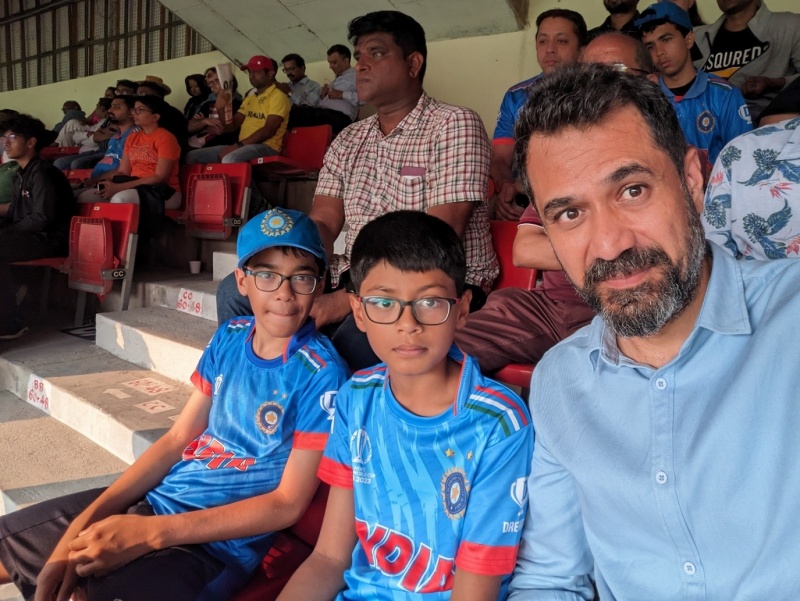
We were surprised at how full the stadium was for a non-India game. Given the sparse attendance at the other centres, my glass of expectation was at best half-full. Yet we were confronted with a wall of noise immediately upon entering our stand. There wasn’t an empty seat in our stand, nor in any of the other cheaper to mid-range stands.
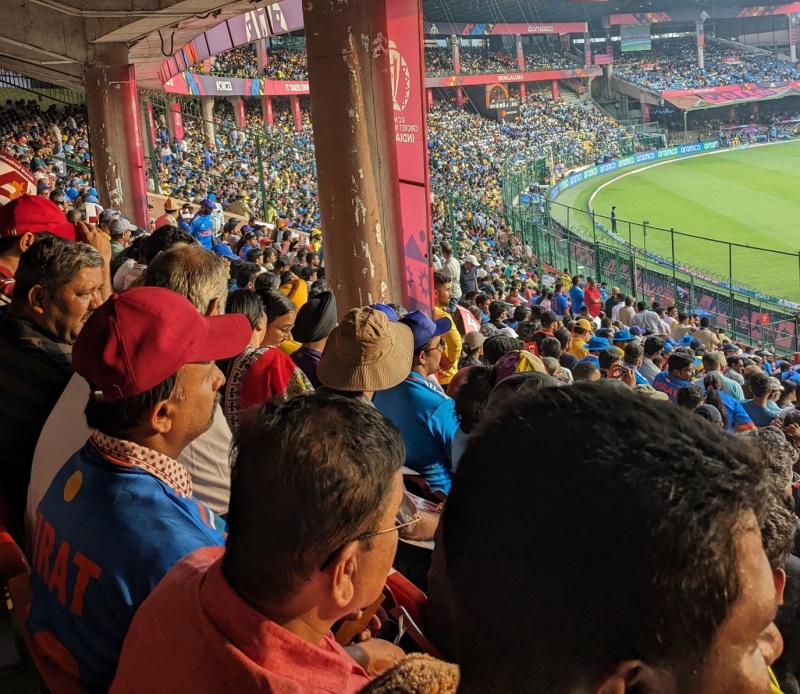
While the overall ground was easily at 75% capacity, a few stands were embarrassingly empty. The huge Members’ Stand – nominally for the state cricket association members and their guests, but used almost exclusively to bestow patronage – which has the best view of the pitch was less than a quarter full.
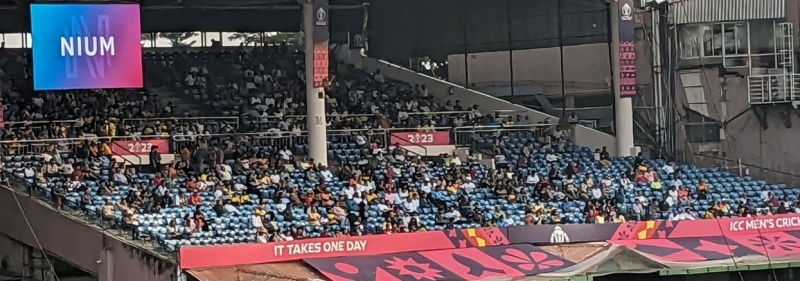
Similarly, the sponsors’ and hospitality boxes were virtually empty for a game that held immense cricketing interest but no prestige in attendance. The only other stands that had vacant seats were those out of the reach of all but the richest Indians – it would take a lot for an Indian family to spend Rs. 60,000 (£600) or more on a non-India cricket match. This contrasting attendance spoke of poor judgment in both allocating and pricing match tickets.
The reason behind such massive interest in third-country matches is, of course, the IPL. A comfortable 20% of the crowd was wearing yellow, and the vast majority of those had Glenn Maxwell’s name on the back. Maxwell is the star player of the Royal Challengers Bangalore, and like AB de Villiers and Chris Gayle, a bonafide Bengaluru maga.
Having grown up in an extremely partisan Indian cricketing culture, I still rub my eyes in wonder when I hear an Indian crowd chant a foreign player’s name with genuine love – in this case the rather unimaginative “Maxieee, Maxieee!”.
David Warner also got dollops of affection from the Bangalore crowd, presumably as much for his Indian dance moves on Instagram as for his batting.
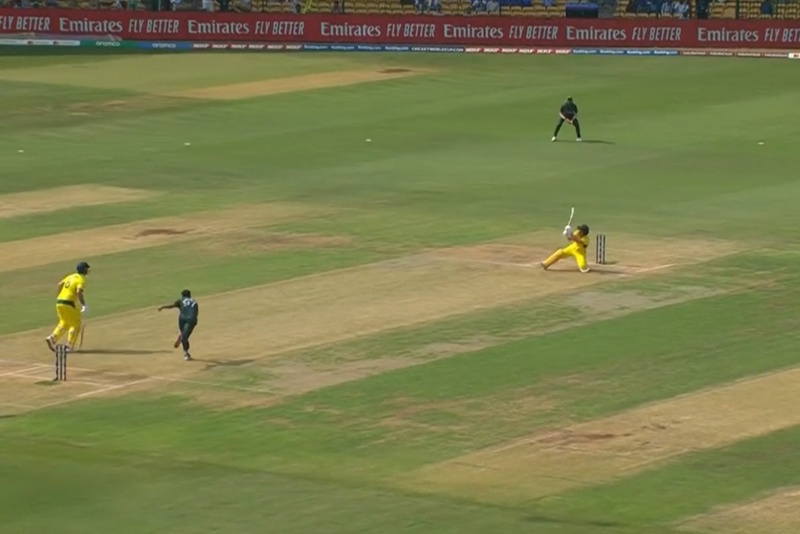
The cricketing admiration was reserved for Adam Zampa, the tormentor of Bangalore’s favourite son Virat Kohli; and hearteningly Shaheen Shah Afridi, who has lately been less effective at destroying Indian batsmen’s stumps and so can be applauded safely.
The food
The kids, thankfully, understood none of this and focused on enjoying the game on pure cricketing merit. Their concentration was broken repeatedly – and willingly – by the variety of food on offer in our stand. I have watched international cricket at many grounds in India and abroad, and in matters of food, Bangalore stands head and shoulders above them all.
Earlier this year I watched a Test match in Delhi from an expensive stand, and our lunch was a box containing a soggy sandwich, an insipid, cold samosa and a box of Frooti. In Bangalore, we feasted on dosas with hot sagu, soft thatte idli, three kinds of vada, chicken biriyani, dahi puri, popcorn and kulfi – all freshly prepared on site.
A set of two dosas cost Rs. 100 (£1) and excellent chai and filter coffee were to be had for Rs. 20 (20p) a cup. It is a matter of immense joy for me that the authorities haven’t succumbed to the temptation of giving the entire food concession to Dominos or KFC and instead provide fresh local food at reasonable prices.
The downside… the DJ
The IPL giveth, and naturally the IPL taketh away. While some of the IPL’s famed “innovations” – cheerleaders, after-parties with the players – have mercifully faded away, one has cemented its place in the Indian stadium experience: the on-ground DJ.
While I have grudgingly come to accept the role of music between overs and upon wickets and boundaries, the DJ’s ever-expanding job description is a source of much distress. It started with the notorious IPL countdown – itself an artifact of the “strategic timeout” in the middle of a T20 innings to create more advertising time – where an MC was thought to be necessary to read the on-screen numbers to the audience. Now the DJ/MC provides “commentary” before and after every ball, shills the sponsors’ names and products, exhorts the crowd into Mexican waves and chants and provides “energy” to the proceedings. The only time he is not shouting is when the ball is actually being delivered and hit. I’m quite prepared for him to start appealing on behalf of the fielding side and asking for DRS reviews soon.
Eight hours of this aural assault is classified as a human rights violation in many countries, but my problem with the DJ goes beyond the noise. First, he infantilises the audience by constantly violating the “show, not tell” premise of any performance art. Shouting “THAT’S A CRACKING SHOT” or “BOWLED ’IM” immediately after the event assumes the crowd needs help reaching that conclusion. Second, it leaves no space for a genuine crowd response. The player-crowd connect is the entire point of having a live audience at the stadium. When the DJ continuously tells the audience how to react – the high-decibel equivalent of the “laugh” and “applause” placards they hold up at TV show recordings – he prevents the organic build-up of crowd energy in support of, or in opposition to, a player or a team. The DJ makes it impossible for the crowd to be the twelfth player of a cricket team, and Indian cricket is the poorer for it.
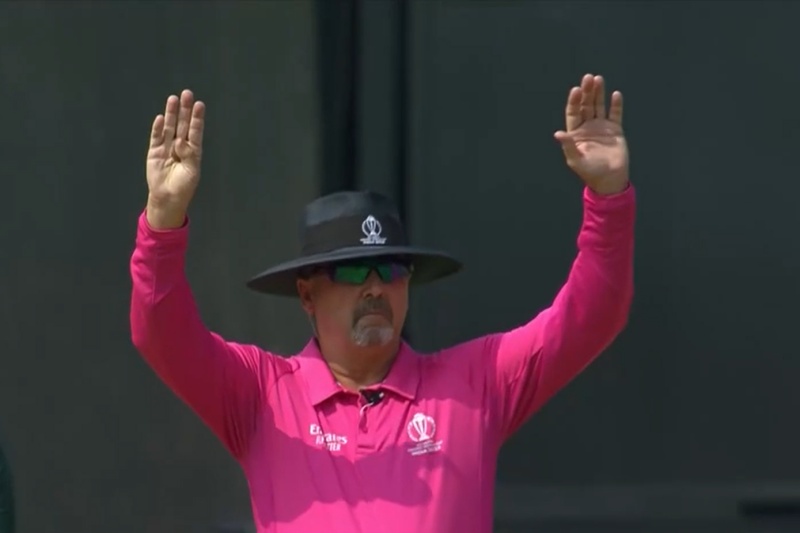
My kids reacted to this tragedy with a grace only children can muster. Throughout the game, they kept up a parallel commentary mocking the DJ. Their reactions ranged from puerile giggling at his chants of “Ho Ho!” to multilingual puns that made me proud. By the end of the match, they were taking bets on which hackneyed line he will repeat in the next over (“IT’S A YUUUUGE SIX” was the consensus winner).
Reception
Given this was a Pakistan game, I was concerned about crowd behaviour towards the Pakistani players. While nobody expected an Indian crowd to get behind the Pakistan team, the Bangalore crowd was sporting to a fault. The Pakistan players were applauded without hesitation, and younger son and I felt entirely comfortable cheering for wickets and boundaries by the Pakistanis.
The crowd tried to engage the Pakistan players on the boundary (respectfully, like we do the Indians), but with one or two exceptions (thank you Shaheen and Shadab!) they refused to even look at the crowd. The majority of the crowd was neutral, while the yellow shirts were rooting for their favourite Aussie players for entirely cricketing reasons. There were no rude or jeering chants.
Right at the end of the match, I feared the worst when my entire stand erupted in chants of Vande Mataram, India’s national song – till I was both delighted and charmed to learn that the chant was being led by an Australian man wearing a yellow kurta. It was a gesture of gratitude towards the Indians, not of aggression towards the Pakistanis.
Conclusion
An excellent day’s cricket was capped by an act of kindness that is entirely Bangalorean. As we were walking out past the concession stands, the kids demanded one last ice cream. I hesitated, carefully considering which was worse – listening to them complain the whole way back, or hearing them bounce around in the car with the sugar rush. The ice cream vendor, a kindly lady who had clearly seen this dynamic before, came up bearing two cones that she offered to the children and refused to take payment for.
As the children licked their ice creams with satisfaction, I felt a sense of satisfaction too – from belonging to a city with a real cricketing culture; from a stadium experience unlike any other in the world, the DJ notwithstanding; from knowing I’m passing my love for the game to a new set of fans.

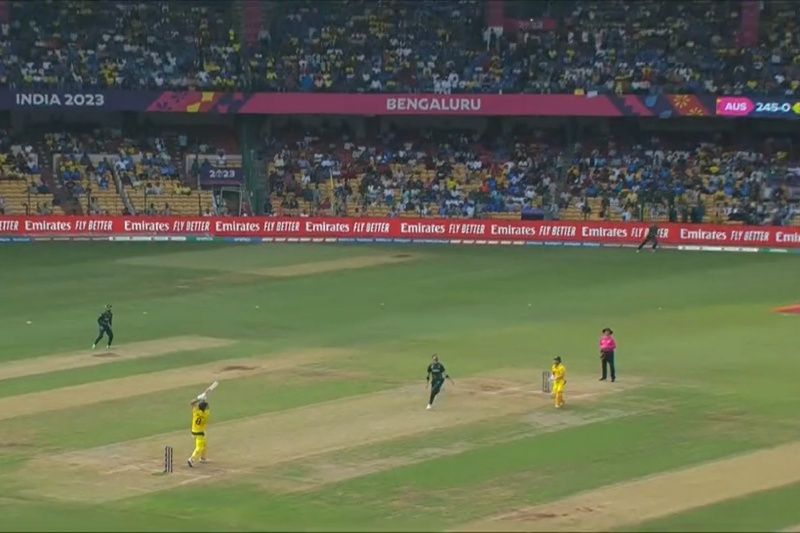

That is a truly wonderful match report, Ritesh. It helped keep me sane during an excruciatingly long call with the bank investigating why, suddenly, I cannot log in to on-line banking. Daisy and I agreed this morning, before she went out, that an hour of my afternoon was likely to disappear down the toilet on that problem. In the event, it was two hours, near enough. Hopefully a new card will solve the problem – I’ll know in 5-7 working days time.
But to your match report, Ritesh. So descriptive, I really sensed the vibes (good and bad). It had a bit of everything (except cricket, obviously). Loved the stuff about your boys, they’re bound to grow up to be cricket badgers which is wonderful. It seems that sone youngsters have the attention span for a whole day of cricket. Who knew?
Also very much enjoyed your take on the catering. Sounds far more homely and wholesome than I would have imagined – thoughts that warmed the cockles of my heart while I was being thanked for my patience, despite the fact that it was nearing 16:00 and I still hadn’t had my lunch.
As for the thumping bollocks noise through the pa, I must admit that Daisy and I felt the same way about the (lower key) constant blather for eight hours at Lord’s during the 2019 World Cup. I think it is an ICC dictat. Possibly “inspired” by the IPL.
I too have watched Australia play Pakistan on a neutral ground, but I didn’t write it up in KC compliant mode nor nearly as well as the Ritesh piece.
https://ianlouisharris.com/2010/07/15/a-day-of-neutral-test-cricket-at-lords-australia-v-pakistan-day-three-with-paul-deacon-mat-tim-15-july-2010/
Thanks again, Ritesh, for this cracking read.
Cheers, Ged. It’s somewhat reassuring to learn that banks all over the world need 5-7 business days to solve any problem. Hope the new card brings happier times!
Great stuff Ritesh. I’d not really stopped to consider why I hate the in-house DJs at the grounds but I think you’ve articulated it perfectly.
Well said, Ratish. Sadly, ‘real’ cricket now appears under threat from these moronic ‘innovations’. There is room for both, but greed appears to be pushing things in one direction, especially in India.
It’s not even greed. It’s mainly that cricket is governed by people who are neither cricketers nor cricket fans. These administrators have a certain view of what constitutes “entertainment” that doesn’t take into account the preferences of people who actually turn up for the game. In their quest to attract new fans, they might end up alienating existing ones (even in India).
Additionally, they have a belief that the Indian fans’ appetite for live cricket is unlimited regardless of the quality, amount and price of the product. This is why seats open to the sun for neutral games are priced at £150, and too many are reserved for sponsors and hospitality partners to give away.
It’s not so much greed as misjudgment. Fans turn up when there is high-quality cricket, comfortable seating at a reasonable price, clean toilets, plentiful food and good access to the stadium. They don’t turn up for cheerleaders, dance music between deliveries or the in-stadium DJ.
Great piece Ritesh – enjoyed it immensely. From what you say, it seems Bangalore does seem to be the second-best cricketing city in India (after Chennai of course) perhaps displacing Mumbai…..
Lol not taking that bait. Let’s just say that Chennai, Mumbai and Bangalore are the three biggest cricketing centers in the country.
Echo the previous comments. This was well worth being published as quickly ad it has been!
Super report, Ritesh.
I like my music loud – but not at a sporting event, or in a restaurant, or on the bus – and certainly not under somebody else’s manic direction.
The local food sounds wonderful, and coffee at 20p a cup means I won’t be able to frequent any of my local coffee shops here in Dublin for quite some time, in case I start an argument with them …..
Having just returned from India I can concur that Bangalore is indeed splendid. As my travel was for work purposes I didn’t manage to go to a game, we were always in the wrong city at the wrong time.
I was out in Bangalore at the Iron Hill Brewery when the SA vs Ned match was unfolding and no-one could take their eyes off it.
Enjoyed reading that — the food sounds outrageously good.
Fantastic report, Ritesh. Having recently moved out of Bangalore, it brought back a wave of happy memories. Also glad to see that the Aus-Pak game was well attended, sportingly supported and wholesomely fed. I always took a bit of joy out of being able to see the Chinnaswamy from my home in bangalore, and I could almost do that again through your submission. Thank you!